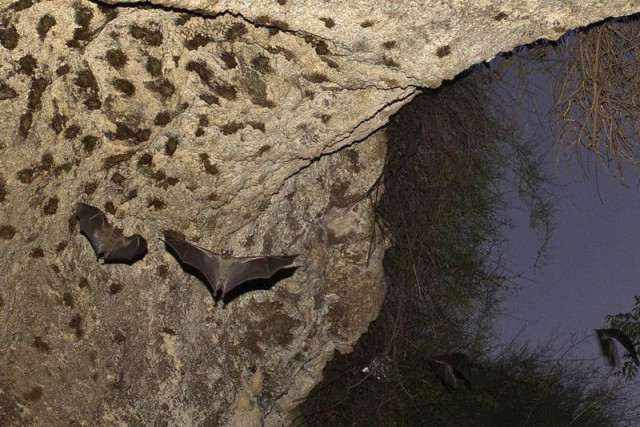Frightened citizens endanger megabats in Sindh’s villages
Wildlife experts, conservationists assure the fox-like winged mammal poses no threats

Around 40 megabats were shot dead in Nawabshah allegedly by the police, acting on directives from higher ups, after villagers lodged a complaint against the winged creatures.
Last week, a man in Sukkur posted on his social media account that a bat had injured him. Although investigations carried out by both the district authorities and the Sindh wildlife department (SWD) concluded that the allegation was false, local residents expressed fear of the large bats.
Several such incidents have been reported in different parts of the province. In some areas, villagers have resorted to killing megabats, endangering their population.
Herbivores and harmless
Megabats, also called flying foxes or fruit bats, have a wingspan of over four feet. They can often be spotted in Sindh's villages clinging to branches of fruit trees or crawling on the ground. Megabats are known to have an excellent sense of smell.
"They are herbivores, they do not harm anyone [humans]," said SWD Sukkur Deputy Conservator Adnan Khan, who has been observing megabats in the region for the past 20 years.
There are around 400 megabats hanging in the trees of Lab-e-Mehran Park alone, said Khan. They live near water or prefer to build nests in old buildings and trees, he elaborated. "A bat can travel upto 165 kilometres at night in search of food," he shared, adding that they only eat insects besides fruits and vegetables.
Megabats can be found in six countries across the world - Pakistan, India, Sri Lanka, Nepal, Bhutan and Maldives. The Indian variety - the flying fox or fruit bat - that are found in Sukkur are the largest in the world, said Khan. "They transfer pollen and help farmers get better and timely cultivation."
They give birth to one child in a year and can be found across Sindh. Sightings are common in Sukkur, Nawabshah, Mirpurkhas, Sangar, Badin, Thatta and in Karachi's Malir district.
The large, winged mammal may not have a pretty face, said Khan, but he has never known the animal to attack anyone. "They are like other animals and birds. Have you ever seen a goat or sheep harming people? The megabat's like them, harmless animals."
Read More: SWD sets free two hawks
However, citizens remain frightened of megabats. "We caught one last month and caged it till it died," said Abdul Sattar, a resident of Thatta. "It's an ugly bird. Most people have not seen it before and believe it is the changing face of a fox."
The population of bats in the region is thinning out, SWD Chief Conservator Javed Ahmed told The Express Tribune. Megabats, which needed to be protected, were being killed, he said, adding that SWD teams have been tasked with clearing the fox-like bats from residential areas and generating awareness and sensitivity among citizens. There was no veracity to reports of anyone being bitten by a megabat in Sukkur, he said.
In a bid to protect the species, posters and banners have also been put up in Sindh's villages, under a drive launched by the SWD, informing citizens in Sindhi and Urdu about megabats and their characteristics.
Published in The Express Tribune, August 17th, 2021.



















COMMENTS
Comments are moderated and generally will be posted if they are on-topic and not abusive.
For more information, please see our Comments FAQ